|
|
The wish to rebuild a vintage bike had been on my mind for quite a long time. However, a postwar Single-Cylinder BMW was my primary aim. But even for a pile of scrap metal the prices of a BMW were not really favorable.
|

|
|
In April 2002 while reading a small local biker newspaper, the 'KradBlatt', I stumbled over a small ad saying:
IFA BK 350, BJ 1955, Engine and Gearbox reworked
with new bearings, solid frame and sheet metal parts
rear wheel drive OK, 1100 Euro
The attraction of the ad clearly lay in the combination of year of manufacture and price.
|
|
|
But what the hell was an IFA BK 350????
I had never heard of such a bike! So I went to the bookshelf, got the 'Encyclopedia of the Motorcycle', and began with the search and found what I was looking for: A look at the photo, made my heart go pitter-patter. This seemed to be a 'smaller' version of what was already parked in my garage: opposed twin with shaft-drive - still with nice single seats, and a two-stroke engine - 2-Stroke??? -, I couldn't believe it.. But OK why not again a two stroke? Visions of billows of thick blue smoke passing through my thoughts...
The next question that came to my mind was: Would there still be parts available for this bike?? I had a look on the internet. Let's see what Google and friends come up with when I type in "BK350".... and very much to my surprise, many hits of BK sites that actually contained useful information about this bike. So I printed out the instruction manual and the parts list long before I bought the motorcycle.
After two days of investigation I was certain about my decision to call the guy who has this bike. Especially interesting was that his phone number had the same prefix as mine. On the 26th of April 2002, I had the first chance to see 'my soon to be' BK.

After a short back and forth exchange, the salesperson and I closed the deal. My wife's question: "And you are really sure that this pile of sheet metal with an engine, is really what you want?" I took her query as her blessings for my purchase.
Until the bike arrived, thanks to the BK-Forum and other sites I found on the Web, I had already located the addresses of several spare parts sources. With the help of the Internet and the BK Forum, I was also able to fill in some of my educational gaps in the area of the bike's construction.
On the 12th of May 2002, I picked up all the parts. Inquiries went out for parts the following day. As the first parts arrived one piece at a time, it became Christmas every day for me.
I am certain, however, that I am not alone with these sorts of experiences.
My first new acquaintances related to this bike were made mostly through the BK forum. That's how I met Matthias, who sold me his spare set of handle bar risers.
Also Ingolf (from Leipzig), who gave me a good introduction to the technology, (now piling up in my cellar), by sending me a lot of emails detailing his experiences and in depth technical data, not to mention his humorous anecdotes. These gentlemen helped me a great deal. Until now I had never seen a motorcycle like this.
The time had finally come to take the sheet metal to the paint shop. My first attempt in matters of restoration were my newly bought rubber saddle covers. I can only recommend everyone to have a good breakfast before trying to install them onto the frame.... I was sore for days afterwards.
A few weeks later I met another man named Ingolf. He also lived in Hamburg and owned a BK350 with a Stoye sidecar (later he changed to a Wünsche sidecar). This was the first time I saw and heard a BK 'live'. He also gave me a tip about where a good plater could be found in Hamburg.
Through Ebay I acquired some vintage literature about the technology of the post war German Democratic Republic (East Germany to you Anglo-Saxons).
'Kraftfahrzeug Technik' Ein Lehrbuch für die Motorsportler der GST, 1954
'Handbuch für den Motorradsportler' von Obering. S. Rauch, 1954
'Fachkunde Kraftfahrzeugschlosser' von 1958
'DDR - Motorräder' von Schrader Motor Chronik
|
|
|
From these books, I learned a lot about the history, the machines and the technology of the former East Germany. This information was not spread commonly to the western part I was living in.
Finally the parts came back from the paint shop. Now I could start with the assembly of the bike. It was already mid July when I screwed four big hooks into my cellar ceiling. With four chains hooked to the frame, the bike looked mighty sorry indeed.
|
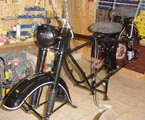
|
|
Now it was the rear wheel drive's turn.

In order to strip the old paint, I simply chose to sandblast it. I closed all openings of the drive with corks, rags etc. The paint came off wonderfully, however my plugs were not nearly as tight as I thought. The bevel gear looked like a desert inside. I had to take the drive completely apart. This was a good opportunity to change the bearings anyway. I hate worrying about unknown roller bearings!
|
|
|
Of course, the appearance of my freshly painted tank compensated for any hassle!
On the 13th of August 2002, I bought a sidecar. I have to admit that the DUNA did not exactly match the style of sidecar, which would have been attached to a BK, but the 'jet form' simply fascinated me. Now before I start the restoration of the sidecar quite some time will pass by. The BK should be made ready first.
|
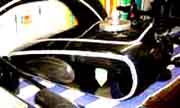
|
|
On the 14th of August the parts from the plater returned and I could mount the rear wheel drive to the frame... the first visible success experienced since bringing the bike home. On the 13th October 2002, I joined the IG-BK. This is a group of people who share the love of this motorcycle. Through them I acquired additional hints and parts to complete the bike work. The BK assembly progressed slowly.
If somebody needs to attach fork gaitors, I really can recommend a way using plastic foil, it works very well! It was the clearance of the new Pertinax sleeves which where less amusing. I had forgotten to check them before I assembled the forks.
|
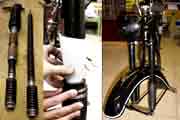
|
|
Then, the great moment came where I wanted to fire the engine up for the first time. The new wiring harness admittedly was good, but if one does not attach it to the right clamps, one will certainly experience some problems with it.
But a few hours later, I had spark, and with a small animal water feeder used as a tank (Ingolf from Leipzig gave me that idea) I flooded the carburetors.
I kicked the engine through twice with spark off, then followed by a kick with spark on and..... I don't believe it... the engine came to life!! First Kick!!
|
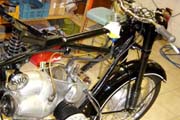
|
|
The right picture shows a good method to synchronize the throttle cables. Use a small mirror in order to be able to see both throttle slides simultaneously.
The sound of the engine was not quite music to my ears. There where still a lot of noises which did not belong in an engine like this.... but we moved the bike out of the cellar into the garage for completion just the same. The first test drive was quite satisfactory. Since I didn't want to make any extended test drive before having a valid license plate, I did not do any further testing.
|
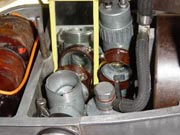
|
|
To get the license plate every vehicle in Germany has to be inspected by the authorities. So we rolled the machine on to a trailer and went to the technical inspection center early the next morning. We arrived there by 6:30 AM.
We rolled the bike off the trailer and tried to start it... This was the first time the BK350 proved to me that it had a temper all its own. First it didn't start, then the carburetors where still leaking gas, even though I stopped pressing the tickler early on. Whenever if it came to life, it died within a few moments.
The examiner probably felt a little sympathetic toward me. Although he pushed the bike more than driving it on his test ride, and even the time the engine was running it was only one cylinder working, he gave me the badge with these words, "If you make this into two cylinder bike, it will be a real sweetie"
A heavy weight was lifted off my heart, and as fast as possible we rolled the bike back up on the trailer and promptly split. When we arrived at home we tried to start the engine again. One kick! The engine came to life and ran like a charm. I attached the plate to the bike and drove around the block. Everything seemed fine and I was grinning like a jackass eating cockleburs. After about10 minutes the engine got slower and strange noises were coming out of the crankcase. I went back and left the bike in the garage until morning. Until now I hadn't opened the engine. It was fully serviced and ready for work, or so I was told. Anyway, I yanked the cylinders and had a close look at the insides. The crank was shot, and the pistons and cylinders were worn out. I pulled the engine and disassembled it. The crank went out for repair, and the cylinders had to be bored and new pistons were ordered. It was really hard to wait until all parts came back. After the engine was assembled and back in the frame, there was still a strange hard metal sound when the engine was at idle.
During driving the engine worked really fine. I went 100km through the countryside without any problems. For the next trip I took my wife with me. It was 140km of pure fun! I was highly enthusiastic! But then all of a sudden, the engine died at every traffic light. It was really hard work to get it back to life again. It got even worse on the way back home. The last 30km we had to stop every 6 or 7 km to let the engine cool down and free up the piston. At home a look at the bores made my heart sink. The left piston looked like the Grand Canyon. The right side had no damage at all.

Since the bore didn't look quite so badly, I ordered only a new piston. After some back and forth thinking, I decided to use the old pistons as long as I found out the reason for the problems.
This search took me almost 4 months. During this time Dieter Heyne really proved to be a patient man. Dieter is a carb specialist, and the BK didn't even want to run for him with fully tested new carburetors. (Here a special thanks to him!)
As time went by I found quite a few mistakes. For example: different guts in the mufflers. I found this when the problem switched sides as I switched the mufflers. Jammed gas hoses, wrong engine/carburetor cover, 17HP variant part instead of the 15 HP part, which caused insufficient air when riding at higher speeds.
The springs on the mechanical advance were too strong. This was responsible for the metallic sound at idle, plus an uneven idle speed resulted. The next problem was a completely ailing regulator and faulty ignition coils.
On the 14th of October 2003, we met with three BK's in Hanover near the Dinosaur Park. Totally 330km of driving without problems and with Sozius. I made it! At least in Summer with temperatures above 18 degrees centigrade... If colder the engine starts immediately, but dies off as quickly as it started. But who wants to drive with his beautiful historic bike through the countryside when it's freezing out.
On a swap meet at the Augustusburg near Chemnitz in January 2005 I bought a cheap rebuilt exhaust system for the BK. But the neither sound nor the driving performance matched my expectations. Beginning of 2006 I managed to get some plans about how the original exhaust was build. (Thanks to Gerald Riechers from the IG-BK) How I modified the rebuild to match the original ones, you can see in the details section. It was definitely worth it, the sound is good and she runs much better than before.
|

|